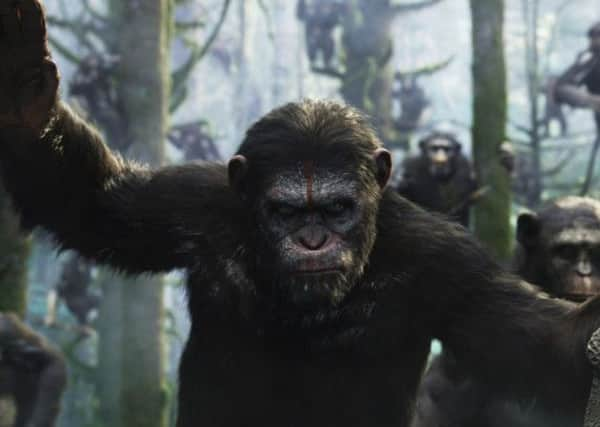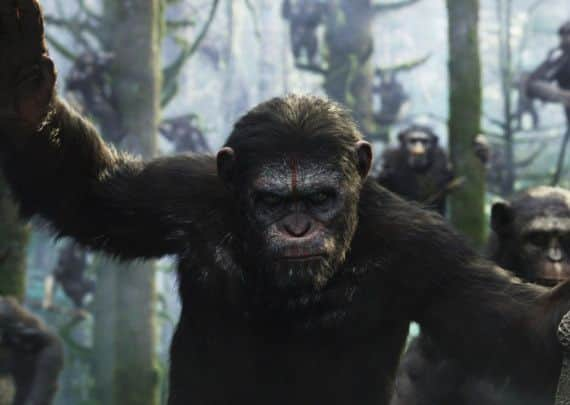Film review: Dawn of the Planet of the Apes (12A)


DAWN OF THE PLANET OF THE APES (12A)
Directed by: Matt Reeves Starring: Andy Serkis, Jason Clarke, Gary Oldman, Keri Russell, Toby Kebbell
Star rating: * * *


The old “infinite monkey theorem” – give a chimp enough time punching random keys on a typewriter and he’ll eventually deliver the complete works of Shakespeare – seems to have found an amusing parallel in Hollywood’s approach to the Planet of the Apes franchise. With four sequels to the 1968 classic, a spin-off TV series, and an ill-judged Tim Burton “re-imagining”, a lot of faith has clearly been put into the theory that revisiting the original concept again and again might one day result in someone making something good out of it once more.
Advertisement
Hide AdThat happened three years ago with Rupert Wyatt’s unexpectedly entertaining Rise of the Planet of the Apes, which played like a blockbuster cousin to Project Nim. Its success was almost entirely down to Andy Serkis’s motion-captured performance as Ceasar, the lab chimp whose enhanced brainpower following medical testing for a new Alzheimer’s treatment made him a compellingly conflicted protagonist. Painfully aware of the plight of his fellow primates thanks to his growing simian consciousness, he was torn by his loyalty to his species and his love for his human rescuer (James Franco), something Serkis used to turn Ceasar into the character audiences empathised and identified with the most.
The best thing about Dawn of the Planet of the Apes is that it follows this trajectory. Set ten years on from the events of the first film, it finds Ceasar and his fellow apes living in the mist-shrouded Muir Woods just north of San Francisco.
With humanity (including Franco) all but wiped out following a simian flu epidemic caused by all that hubristic monkeying around with experimental drugs, the apes have been left relatively free to develop a new society, one comprising treetop fortresses, evolved hunter-gatherer techniques, a sophisticated form of sign language and an idealistic set of principles that Ceasar, who has a sincere belief in the moral superiority of apes, reckons is eminently achievable.
New franchise director Matt Reeves (Cloverfield) takes his time setting all this up, dispensing with the decimation of the human race over the opening credits and dropping us into the ape world to let us see how their nascent society functions.
True to the more grounded approach of the previous film, which exploited the advances in technology to allow Serkis and his fellow motion-capture performers to play the primates with a higher degree of believability than ever before, Reeves doesn’t betray this by having them gabbing with each other from the off.
Their language comprises a complex mix of signing and speech, and Ceaser’s own language skills, while more advanced, aren’t humanlike the way they were in the original series. He’s articulate, but not verbose – an ape of few words determined to make those words count.
Advertisement
Hide AdSince last we saw him he’s also become a father, and his relationship with his somewhat rash eldest son, Blue Eyes (Nick Thurston), becomes a major one in the film, underscoring his desire to create a society that improves upon the human world in which he was raised.
The main addition to the chimp cast, though, is Koba, who popped up briefly in the previous film. Now played by Toby Kebbell (Christopher Gordon played him last time), he bears both the mental and physical scars of his previous life in a research facility and, as a result, is less forgiving of the humans than Ceasar – and certainly less trusting of them when a scouting party led by Zero Dark Thirty’s Jason Clarke stumbles across them in the woods.
Advertisement
Hide AdWhen the humans arrive in the film it’s at first a shock – and then a disappointment. Their need to access a dam within the ape territory in order to replenish the dwindling power reserves of their San Francisco-based colony provides the film with a perfunctory plot so that both sides can have debates about whether or not it’s possible to co-exist.
Alas, with Gary Oldman’s ex-soldier becoming Koba to Clarke’s more moderate Ceasar, the battle lines that are drawn have a disappointing predictability about them, to the point where even the treachery that emerges within the simian community feels a little too obvious.
The allegorical simplicity of The Planet of the Apes films has always been their greatest strength, of course, and the way this film continues to make us root for Ceasar is a neat trick.
But at a time when almost every superhero and monster movie attempts something similar (the thematic concerns of the Apes and the X-Men sagas are virtually interchangeable), Dawn of the Planet of the Apes sadly lacks the kind of iconic moments that would really help distinguish it.
The self-importance of being so earnest is what eventually shines through. Those monkeys need to get back to the typewriter.
FILM REVIEWS
FINDING VIVIAN MAIER (12A)
Directed by: John Maloof,
Charlie Siskel
Star rating: * *
At first glance it’s impossible to resist the appeal of Finding Vivian Maier, John Maloof and Charlie Siskel’s documentary detective story piecing together the mysterious life of the titular New York nanny who dedicated her life to taking thousands of remarkable photographs, only to die in poverty, obscure and alone, having never really shown her work to anyone.
Advertisement
Hide AdVery much part of the street photography tradition, her work found real visual poetry in the banality of the everyday, yet she barely developed any of the thousands of rolls of film Maier shot, and it wasn’t until
fleamarket entrepreneurs – Maloof among them – started stumbling across boxes of her negatives in clearance auctions that it began to reach a wider audience via the internet.
Advertisement
Hide AdAs Finding Vivian Maier has it, once Maloof started posting images on photographic blogs
to see if anyone else thought they were as good as he did, interest in her work went viral and so, with only a recent obituary notice and a few clues to go on, he set out to secure as much of her work as possible and
embarked on simultaneous mission to find out who this woman was.
Casting himself very much as the curator of her legacy, Maloof’s intention to share her work is presented here as a noble endeavour – and it is, in as much as the initial exhibitions he organised, and the work he’s done to get Maier’s photos out there (including painstakingly scanning and funding the printing of her work) have brought a lot of joy to people who adore great photography.
Nevertheless, there’s something a little suspect about the fact that in addition to being one of the film’s subjects as well as its co-director, he’s also the chief beneficiary of Maier’s expanding public profile. The film does touch on some of the ethical issues this throws up, but it does so in a very soft-focus way.
More disappointingly, as it gets caught up in the prurient – and not very interesting – details of Maier’s myriad personality quirks (and possible mental disorders), any interest in exploring the artistic value of her work falls by the wayside.
Advertisement
Hide AdEarly on, for instance, Mary Ellen Mark likens Maier’s photos to those of Diane Arbus and Robert Frank, but Maloof never thinks to ask her if Maier might have been consciously echoing their work to develop her own style.
Instead the film would rather perpetuate the myth of the artistic savant, perhaps because, in an
Advertisement
Hide Adage in which anyone with a smartphone can take a half-decent picture, it’s more romantic and appealing than making a film about someone who may just have been disciplined about mastering an art form they clearly loved.
I Am Divine (15)
Directed by: Jeffrey Schwartz
Star rating; * * * *
A truly transgressive star of the underground who died just as he was about to attain mainstream success, the status of drag artist Divine (below) as the queen of the midnight movies is lovingly and entertainingly explored here. The long-term muse of John Waters, s/he helped him cement his reputation as the Pope of Trash in the 1970s, pushing the envelope of bad taste by chugging down dog poo at the end of Pink Flamingos and inspiring punk with his mohawk and make-up in Female Trouble. The making of those films – as well as the break-out hit Hairspray – is pored over in detail here, as is Divine’s childhood in Baltimore, his pop career and his desire to be taken seriously as a performer. Director Jeffrey Schwartz’s determination to fit Divine’s outsized life into a conventional talking-heads bio-doc may initially seem anathema to everything he was about, but so much of the material is genuinely subversive in its tastelessness, it’s easy to forgive.
Grand Central (15)
Directed by: Rebecca Zlotowski
Starring: Tahar Rahim, Léa Seydoux, Olivier Gourmet, Denis Ménochet
Star rating: * * *
A nuclear power plant is the symbolically clunky locale for this love-triangle drama exploring the toxic effect passion can have when it seeps into the lives of people who can’t be together. Tahar Rahim stars as Gary, an unskilled day labourer who falls for Karole (Léa Seydoux), the fiancée of his older co-worker (Denis Ménochet) after taking a well-remunerated maintenance job at the aforementioned power station in France’s Rhône Valley. With his casual-at-first attitude to love matched by his cavalier attitude to radiation, Gary is in for a double dose of hurt when the seriousness of his emotional connection to Karole and the occupational hazards of his work begin to dawn on him. Despite the thematic obviousness of all this, director Rebecca Zlotowski deploys some interesting stylistic flourishes that prevent a melodramatic meltdown – and Rahim and Seydoux imbue their characters with enough rawness to make them seem believably tormented.
Pudsey the Dog: The Movie (U)
Directed by: Nick Moore
Starring: Jessica Hynes, John Sessions, Luke Neal
Star rating: *
Barrel scraping doesn’t come much more blatant than this. Built around the titular Britain’s Got Talent-winning pooch, this dismal family film is so wretched even Pudsey seems embarrassed to be in it. Charmlessly voiced by David Walliams, Pudsey begins the film taking a playful paw-swipe at Uggie – the canine superstar of The Artist – by wrecking the set of a black-and-white movie and high-tailing it into lives of a single-parent family about to move to a country cottage with a strict no-dogs-allowed policy. What follows is rubbish in every conceivable way.
The Ghosts in Our Machine (N/A)
Directed by: Liz Marshall
Star rating: * * * *
“I don’t take photographs of animals,” says photographer and animal rights campaigner Jo-Anne McArthur in this haunting documentary following her quest to make us question our relationship with animals by thinking of them as sentient creatures. “I take photographs of the predicaments animals find themselves in because of humans.” Documenting fur farms, abattoirs and research laboratories, as well as shooting portraits of animals rescued from these facilities, McArthur’s work is simultaneously beautiful and upsetting, and Liz Marshall’s film works in the same way. Full of footage of McArthur going about her job, it illuminates a moral and ethical dilemma most of us choose not to think about – unless you’re watching blockbusters about damned dirty apes of course.
Stereo, Glasgow, tonight (www.earthmovies.org/p/projects.html)